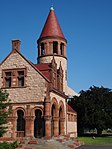Cambridge, Massachusetts

Cambridge ( KAYM-brij) is a city in Middlesex County, Massachusetts, and part of the Boston metropolitan area as a major suburb of Boston. As of the 2020 United States Census, the city's population was 118,403, making it the fourth most populous city in the state, behind Boston, Worcester, and Springfield. It is one of two de jure county seats of Middlesex County, although the county's government was abolished in 1997. Situated directly north of Boston, across the Charles River, it was named in honor of the University of Cambridge in England, once also an important center of the Puritan theology embraced by the town's founders.: 18 Harvard University, the Massachusetts Institute of Technology (MIT), Lesley University, and Hult International Business School are in Cambridge, as was Radcliffe College before it merged with Harvard. Kendall Square in Cambridge has been called "the most innovative square mile on the planet" owing to the high concentration of successful startups that have emerged in the vicinity of the square since 2010.
Excerpt from the Wikipedia article Cambridge, Massachusetts (License: CC BY-SA 3.0, Authors, Images).Cambridge, Massachusetts
Irving Street, Cambridge
Geographical coordinates (GPS) Address Nearby Places Show on map
Geographical coordinates (GPS)
| Latitude | Longitude |
|---|---|
| N 42.373611111111 ° | E -71.110555555556 ° |
Address
Cambridge Rindge & Latin School
Irving Street
02143 Cambridge
Massachusetts, United States
Open on Google Maps








